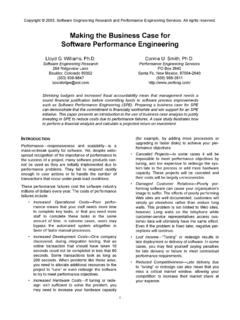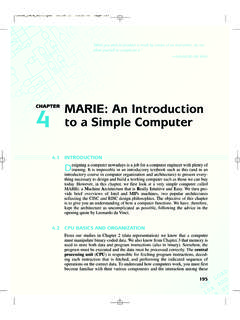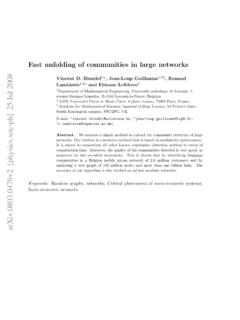Transcription of Performance Engineering Evaluation of Object …
1 Performance Engineering Evaluationof Object -Oriented Systems with SPE ED Connie U. Smith and Lloyd G. Williams Performance Engineering ServicesPO Box 2640, Santa Fe, New Mexico, 87504-2640(505) 988-3811, ~cusmith Software Engineering Research264 Ridgeview LaneBoulder, CO 80302(303) 938-9847 Appears in: Computer Performance Evaluation : ModellingTechniques and Tools, No. 1245, ( , eds.), Springer-Verlag, Berlin, 1997, Performance Engineering Services andSoftware Engineering ResearchAll Rights ReservedThis material may not be sold, reproduced or distributedwithout written permission from Software EngineeringResearch or Performance Engineering ServicesPerformance Engineering Evaluationof Object -Oriented Systems with SPE ED Connie U. SmithLloyd G. WilliamsPerformance Engineering ServicesSoftware Engineering ResearchPO Box 2640264 Ridgeview LaneSanta Fe, NM 87504 Boulder, CO 80302 ~cusmithAbstractAlthough Object -oriented methods have been shown to help construct software systems that areeasy to understand and modify, have a high potential for reuse, and are relatively quick andeasy to implement, concern over Performance of Object -oriented systems represents asignificant barrier to its adoption.
2 Our experience has shown that it is possible to design Object -oriented systems that have adequate Performance and exhibit the other qualities, such asreusability, maintainability, and modifiability, that have made OOD so successful. However,doing this requires careful attention to Performance goals throughout the life cycle. This paperdescribes the use of SPE ED, a Performance modeling tool that supports the SPE process, forearly life cycle Performance Evaluation of Object -oriented systems. The use of SPE ED forperformance Engineering of Object -oriented software is illustrated with a simple IntroductionObject-oriented development (OOD) methods have been shown to be valuable inconstructing software systems that are easy to understand and modify, have a highpotential for reuse, and are relatively quick and easy to implement.
3 Despite thedemonstrated successes of OOD, many organizations have been reluctant to adoptobject-oriented techniques, largely due to concerns over experience has shown that it is possible to design Object -oriented systems thathave adequate Performance and exhibit the other qualities, such as reusability,maintainability, and modifiability, that have made OOD so successful [Smith andWilliams, 1993]. However, doing this requires careful attention to Performance goalsthroughout the life cycle. Failure to build-in Performance from the beginning canresult in the need to tune code, destroying the benefits obtained from a carefulobject-oriented design. In addition, it is unlikely that tuned code will ever equal theperformance of code that has been engineered for Performance . In the worst case, itwill be impossible to meet Performance goals by tuning, necessitating a complete re-design or even cancellation of the Performance Engineering (SPE) for Object -oriented systems is especiallydifficult since functionality is decentralized.
4 Performing a given function is likely torequire collaboration among many different objects from several classes. Theseinteractions can be numerous and complex and are often obscured by polymorphismand inheritance, making them difficult to trace. Distributing objects over a networkcan compound the of the principal barriers to the effective use of SPE with OOD is the gap betweenthe designers who need feedback on the Performance implications of design decisionsand the Performance specialists who have the skill to conduct comprehensiveperformance Engineering studies with typical modeling tools. This gap means thatextra time and effort is required to coordinate design formulation and analysis,effectively limiting the ability of designers to explore design ideal long-term solution to providing SPE assessments during the design stage isan evolution of today s CASE tools to provide decision support for many facets of thedesign including correctness, completeness, Performance , reliability, and so on.
5 Thisapproach, however, is not currently practical. It is too expensive for each CASE vendor to create their own modeling/analysis component. Therefore, we seek a near-term capability to interface CASE tools to existing modeling tools. A previous paperdefined the SPE information that CASE tools must collect [Williams and Smith,1995]. This paper illustrates the translation from Object -oriented design models intoperformance models, and the use of the tool, SPE ED ,1 for early life cycleperformance Evaluation of Object -oriented systems. SPE ED is a performancemodeling tool that supports the SPE process described in [Smith, 1990]. SPE EDssoftware processing focus and automatic model generation make it easy to evaluateOOD architecture and design alternatives. Other features, such as the SPE projectdatabase and presentation and reporting features, support aspects of the SPE processother than paper begins by reviewing related work.
6 This is followed by an overview ofSPE ED. We then present an overview of the process of software performanceengineering for Object -oriented systems. A simple example illustrates the Related WorkObject-oriented methods typically defer consideration of Performance issues untildetailed design or implementation (see , [Rumbaugh, et al., 1991], [Booch, 1994]).Even then, the approach tends to be very general. There is no attempt to integrateperformance Engineering into the development work specifically targeted at Object -oriented systems has emerged from theperformance community. Smith and Williams [Smith and Williams, 1993] describeperformance Engineering of an Object -oriented design for a real-time , this approach applies general SPE techniques and only addresses thespecific problems of Object -oriented systems in an ad hoc ED is a trademark of Performance Engineering et.
7 Al. [Hrischuk, et al., 1995] describe an approach based on constructing anearly prototype which is then executed to produce angio traces. These angio tracesare then used to construct workthreads (also known as timethreads or use case maps[Buhr and Casselman, 1992],[Buhr and Casselman, 1994], [Buhr and Casselman,1996]), which are analogous to execution graphs. Workthreads provide empiricalinformation about traversal frequencies for data-dependent choices and times are estimated. This differs from the approach described here in thatscenarios are derived from prototype execution rather than from the design and thesystem execution model is then generated automatically from the angio propose an integrated Object -oriented CASE tool for software designthat includes a simulation capability for Performance assessment [Baldassari, et al.]
8 ,1989, Baldassari and Bruno, 1988]. The CASE tool uses petri nets for the designdescription language rather than the general methods described above, thus the designspecification and the Performance model are equivalent and no translation isnecessary. Using these capabilities requires developers to use both the PROTOB method and CASE paper uses the SPE tool SPE ED to conduct the Performance analysis. Othersoftware modeling tools are available, such as [Beilner, et al., 1988, Beilner, et al.,1995, Goettge, 1990, Grummitt, 1991, Rolia, 1992, Turner, et al., 1992]. Theapproach described here could be adapted to other tools. Adaptation is necessary forthese other tools that do not use execution graphs as their model SPE ED OverviewThis section gives a brief overview of the features of the SPE tool that make itappropriate for OOD (and other) evaluations throughout their development life FocusSPE ED 's focus is the software Performance model.
9 Users create graphical models ofenvisioned software processing and provide Performance specifications. Queueingnetwork models are automatically generated from the software model combination of analytic and simulation model solutions identify potentialperformance problems and software processing steps that may cause the ED facilitates the creation of (deliberately) simple models of software processingwith the goal of using the simplest possible model that identifies problems with thesoftware architecture, design, or implementation plans. Simple models are desiredbecause in the early life cycle phase in which they are created: developers seldom have exact data that justifies a more sophisticated model, they need quick feedback to influence development decisions, they need to comprehend the model results, especially the correlation of thesoftware decisions to the computer resource Model descriptionUsers create the model with a graphical user interface streamlined to quickly definethe software processing steps.
10 The user's view of the model is a scenario, anexecution graph of the software processing steps [Smith, 1990]. Software scenariosare assigned to the facilities that execute the processing steps. Models of distributedprocessing systems may have many scenarios and many facilities. Users specifysoftware resource requirements for each processing step. Software resources may bethe number of messages transmitted, the number of SQL queries, the number of SQLupdates, etc. depending on the type of system to be studied and the key performancedrivers for that system. A Performance specialist provides overhead specificationsthat specify an estimate of the computer resource requirements for each softwareresource request. These are specified once and re-used for all software analysis thatexecutes in that environment. This step is described in more detail Model solutionSPE ED produces analytic results for the software models, and an approximate,analytic MVA solution of the generated queueing network model.











